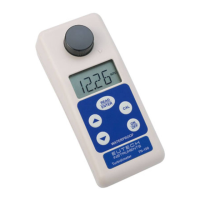Instruction Manual TN-100/ T-100
16
5. Routine Maintenance
The supplied carrying case is optimal for protecting the instrument. If you do not
plan on leaving the instrument in the supplied carrying case, when not in use,
ensure that the instrument has been turned off and that a clean sample vial fitted
with a black cap has been placed in the sample well. This will ensure that a
minimal amount of dust and/or debris will be able to settle on the optics of the
instrument.
5.1 Vials – Handling, Cleaning and Care
Proper measurement of the turbidity of a sample requires the use of a vial that is
free of marks, smudges, scratches and any bacterial growth.
Therefore, sample vials must be handled with absolute care to avoid contamination
or damage, which might change the optical characteristics of the glass. Scratches,
fingerprints, and water droplets on the sample vial or inside the sample well can
cause stray light interference leading to inaccurate readings.
Cleaning the vial is accomplished by washing the interior and exterior of the vial in a
detergent solution. Once cleaned, the vial should be rinsed thoroughly 8 to 10 times
with clean distilled water to eliminate the possibility of detergent buildup and
streaking.
Vials can also be acid washed periodically and coated with a special silicone oil to
fill small scratches and mask the imperfections in the glass. Since the silicone oil
required for this application should have the same refractive characteristics as
glass, it is recommended that the oil be obtained from us. Care should be taken not
to apply excessive oil that could attract dirt or contaminate the sample well of the
meter. Once the oil has been applied to the vial, the excess oil should be removed
with a lint-free cloth. The result should be a sample vial surface with a dry
appearance, but with all imperfections filled with oil.
Sample vials should always be handled from the top or by the cap to avoid
fingerprints or smudges. After a vial has been filled with a sample and capped, the
outside surface should be wiped with a clean, lint-free absorbent cloth until it is dry.
Cleaned and dried vials should be stored with the black caps on. The vials can be
stored in the carrying case. During normal operation you may use any typical glass
cleaner along with a lint free cloth or tissue (Kimwipes®), to clean the outside of the
vials.
Condensation may appear on the vial when your sample is very cold and the
relative air humidity is high. When this happens, the turbidity that you read may be
higher than the actual turbidity due to the light scattered by the condensate on the
vial. If you find yourself in this circumstance, you can alleviate the problem by either
coating the vial with an anti-fogging agent, or by running warm water over the vial
for a short period of time to warm the sample prior to measurement.

